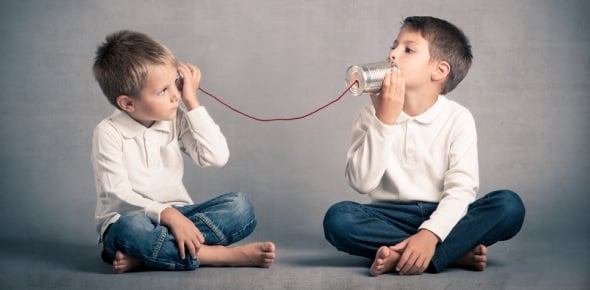38. The cost-benefit/social exchnage theory holds that we work...
101. Talk shows that intentionally promote conflict...
5. The agressive person insists on standing up for his or her...
59. If a group wants to achieve tasks and build relationships,...
60. According to Rosabeth Moss Kanter, kaleidoscope thinking...
32. Control, one of the needs fulfilled by relationships, is...
9. Feelings in themselves are neither positive nor negative;...
33. The theory of social penetration holds that as a...
61. When group members don't have equal status, decisions...
11. Susan and Juan had different views on the issue of increased...
8. The second stage of the Abuse Cycle finds tensions erupting...
6. According to uncertainty reduction theory, when we intially...
7. For some people who express some anger, the risks for disease...
31. According to the text, it is uncommon to be able to tell...
35. The grapevine is an informal conversational network in...
98. According to the situational theory of leadership,
3. Research reported in the text shows that people's moods...
2. Both psychoanalyst Carl Jung and psychologist Elaine Hatfield...
30. Common causes of lying are to avoid punishment and to gain a...
64. For most tasks, a group with how many members seems to work...
12. Toxic Communication includes
51. Interactions designed to open the channels of communication...
36. When we equivocate, we use purposefully vague language.
78. A Fishbone technique
23. Which of these elements is likely to result in high...
24. When it comes to displaying emotions
39. Loneliness results from
4. Conflict always requires two or more people.
66. Mary Ellen Glyn feels that people who see problems as...
16. According to the text, a relationship that has no conflict...
53. According to researcher William Schutz, relationships...
54. Which statement about interpersonal relationships describes...
56. What stage of a relationship is represented by small talk?
83. In order for a conflict to be defined as cooperative, the...
86. When attempting to resolve conflicts, you should
29. Obtaining a marriage license would occur during the...
67. The term risky shift refers to the fact that
72. An effective group climate includes all but which of one of...
77. Which of the following accurately describes how group...
57. The grief process includes
79. A particular kind of communicative act exhibited by a group...
1. When provoked, men and women have equivalent reactions in...
21. When friends drift apart, they are in the ________ stage.
26. Which of these conflict has the greatest potential to...
97. Which of the following statements about the trait theory of...
43. At which stage of a relationship are two individuals first...
45. Most of our "white lies" are designed to benefit
58. Dominating others is a task role.
63. A group is composed of people who
74. Stages of group development include
85. According to Morton Deutsch, conflict can be productive if
100. Our society often seems to be oriented toward cooperation...
13. Which of the following are characteristics of romantic...
48. At what point in a relationship do people become "good...
96. A laissez-faire leader
44. At which stage of a relationship do the participants ask,...
47. The amount of trust we place in another person that can be...
70. A group technique that is used to promote a free flow of...
10. During nascent friendship, we consider ourselves an enemy of...
15. According to Theodore Rubin, an emotional isolationist
19. When we behave nonassertively, which of the following is not...
37. An interpersonal relationship is
75. Which statement describes the different ways that men and...
20. The text lists an "emotional bill of...
84. According to Blake and Mouton, if you are a 5/5 on their...
93. During any discussion involved with settling conflict, it is...
99. When an urgent decision is required, a Type Y leader is the...
71. In group meetings men tend to
17. In a low-intensity conflict, the interactants
22. When two people consider each other friends, they are in the...
28. According to your text, a high-tech-high-touch society is...
41. Breadth of a relationship has to do with
46. Tolerance of vulnerability refers to your
50. A technologically advanced society that values interpersonal...
76. A group whose task is to decide what steps should be taken...
95. Leadership is the ability to
40. Depth of a relationship has to do with
49. A society at home with computers but at a disadvantage when...
65. Charles Redding suggests that an effective group climate is...
42. At which stage of a relationship do people begin to share...
55. Which statement concerning relationships across cultures is...
82. A person who has a competitive set
87. Which of the following statements about role reversal is...
90. Which of the following is true regarding cyber-teams?
18. A pseudo conflict occurs when
14. Which of the following emotions typically results from...
68. What are the three key types of questions in group...
81. Which of the following is not a self-serving role?
88. A person who overvalues the maintenance of relationships is...
89. A person, who when faced with a conflict, adopts a win-lose...
92. On Blake and Mouton's conflict grid, the optimum...
25. Which description of the role of conflict in a healthy...
34. Affection, one of the needs fulfilled by relationships, is...
94. When group members are suggesting possible solutions to...
62. "Averaging" is more effective in making...
80. All of the following are maintenance behaviors except
27. George and Andy became angry at each other during an online...
52. When opposing goals meet, _______ tensions occur.
69. The reflective-thinking framework was developed by
91. Which of the following behaviors would counter the...
73. Which conditions would indicate that an individual rather...
















